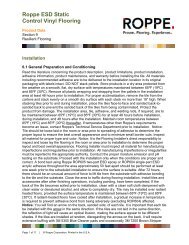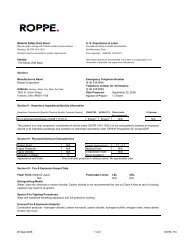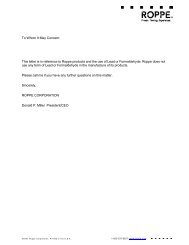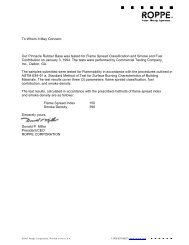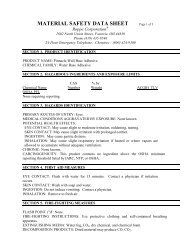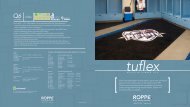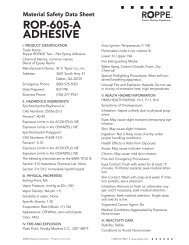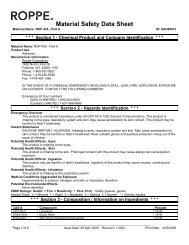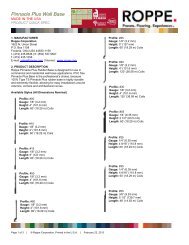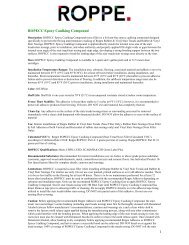MSDS - ROP500 - Roppe Corporation
MSDS - ROP500 - Roppe Corporation
MSDS - ROP500 - Roppe Corporation
You also want an ePaper? Increase the reach of your titles
YUMPU automatically turns print PDFs into web optimized ePapers that Google loves.
MATERIAL SAFETY DATA SHEET<br />
<br />
<br />
Product Name:<br />
Section 1: PRODUCT AND COMPANY IDENTIFICATION<br />
Adhesive<br />
Product Use:<br />
Manufacturer/Supplier:<br />
Adhesive<br />
<strong>Roppe</strong> <strong>Corporation</strong><br />
1602 North Union St<br />
Fostoria, OH 44830<br />
Phone Number:<br />
Date of Preparation: April 28, 2011<br />
Section 2: HAZARDS IDENTIFICATION<br />
EMERGENCY OVERVIEW<br />
CAUTION<br />
While most unlikely, product may cause eye, skin and respiratory tract irritation for those who are highly<br />
sensitive. <br />
dizziness and CNS depression. Containers, while non-flammable, are pressurized and can<br />
burst under fire conditions.<br />
Potential Health Effects: See Section 11 for more information.<br />
Likely Routes of Exposure: Skin contact, eye contact and inhalation.<br />
Eye:<br />
Skin:<br />
Ingestion:<br />
Inhalation:<br />
1-800-537-9527<br />
Emergency Phone: Chemtrec: 1-800-424-9300<br />
Customer Contract No. 202471<br />
May cause eye irritation.<br />
May cause skin irritation.<br />
Not a normal route of exposure.<br />
May cause respiratory tract irritation.<br />
Chronic Effects: Prolonged or repeated contact may dry skin and cause irritation.<br />
Signs and Symptoms: Symptoms may include discomfort or pain, excess blinking and tear<br />
production, with marked redness and swelling of the conjunctiva. Symptoms may include<br />
redness, edema, drying, defatting and cracking of the skin.<br />
Medical Conditions Aggravated By Exposure: Asthma. Allergies.<br />
Target Organs: Skin, eyes and respiratory system.<br />
This product is a "Hazardous Chemical" as defined by the OSHA Hazard Communication<br />
Standard, 29 CFR 1910.1200.<br />
This product is a hazardous chemical as defined by NOM-018-STPS-2000.<br />
Potential Environmental Effects: May cause long-term adverse effects in the aquatic<br />
environment. See Section 12 for more information.<br />
Section 3: COMPOSITION / INFORMATION ON INGREDIENTS<br />
Ingredient UN Number H / F/ R / Special* CAS # Wt. %<br />
1,1-difluoroethane UN1030 Not available 75-37-6 10 - 30<br />
1,1,1,2-Tetrafluoroethane UN3159 Not available 811-97-2 10 - 30<br />
* Per NOM-018-STPS-2000<br />
1 / 6
MATERIAL SAFETY DATA SHEET<br />
<br />
Section 4: FIRST AID MEASURES<br />
Eye Contact:<br />
Skin Contact:<br />
Inhalation:<br />
In case of contact, immediately flush eyes with plenty of water. If easy to do,<br />
remove contact lenses, if worn.<br />
In case of contact, immediately flush skin with plenty of water. Remove<br />
contaminated clothing and shoes. Wash clothing before reuse. Call a physician<br />
if irritation develops and persists.<br />
Move exposed person to fresh air.<br />
Ingestion:<br />
If swallowed, do NOT induce vomiting unless directed to do so by medical<br />
personnel. Never give anything by mouth to an unconscious person.<br />
General Advice: In case of accident or if you feel unwell, seek medical advice immediately<br />
(show the label or <strong>MSDS</strong> where possible).<br />
Note to Physicians: Symptoms may not appear immediately.<br />
Section 5: FIRE FIGHTING MEASURES<br />
Flammability: Not flammable by WHMIS/OSHA criteria.<br />
Means of Extinguishing:<br />
Suitable Extinguishing Media: Powder, water spray, foam, carbon dioxide.<br />
Unsuitable Extinguishing Media: Use water spray to keep fire-exposed containers cool.<br />
Containers, while non-flammable, are pressurized.<br />
Remove from area if this can be done without risk.<br />
Products of Combustion: May include, and are not limited to: oxides of carbon.<br />
Protection of Firefighters:<br />
Personal Precautions:<br />
Section 6: ACCIDENTAL RELEASE MEASURES<br />
Put on appropriate personal protective equipment (see Section 8).<br />
Ruptured cylinders may rocket.<br />
Environmental Precautions: Avoid dispersal of spilt material and runoff and contact with soil,<br />
waterways, drains and sewers. Inform the relevant authorities if the product has caused<br />
environmental pollution (sewers, waterways, soil or air).<br />
Methods for Containment: Contain and/or absorb spill with inert material (e.g. sand,<br />
vermiculite), then place in a suitable container. Do not flush to sewer or allow to enter<br />
waterways. Use appropriate Personal Protective Equipment (PPE).<br />
Methods for Clean-Up: Scoop up material and place in a disposal container. Allow gas to<br />
dissipate harmlessly into the atmosphere.<br />
Other Information: Not available.<br />
Firefighters should wear appropriate protective equipment.<br />
Section 7: HANDLING AND STORAGE<br />
Handling: Observe good industrial practices. Do not eat, drink or smoke when using the<br />
product. Pressurized container: protect from sunlight and do not expose to<br />
temperature exceeding 48°C (120º F). Do not pierce or burn, even after use. Avoid<br />
breathing gas. Avoid breathing vapor or mist.<br />
Storage: Store in accordance with local regulations. Protect from freezing and from direct<br />
sunlight. Store in a dry, cool and well-ventilated area, away from incompatible<br />
materials (see section 10) and food and drink. Use appropriate containment to<br />
avoid environmental contamination.<br />
2 / 6
MATERIAL SAFETY DATA SHEET<br />
<br />
Section 8: EXPOSURE CONTROLS / PERSONAL PROTECTION<br />
Exposure Guidelines<br />
Exposure Limits<br />
Ingredient OSHA-PEL ACGIH-TLV<br />
1,1-difluoroethane Not available. Not available.<br />
1,1,1,2-Tetrafluoroethane Not available. Not available.<br />
Engineering Controls: Use ventilation adequate to keep exposures (airborne levels of dust,<br />
fume, vapor, etc.) below recommended exposure limits.<br />
Personal Protective Equipment:<br />
Eye/Face Protection: As in any construction environment, use approved safety glasses, as<br />
described in OSHA 29 CFR 1910.133. If necessary, refer to U.S. OSHA 29 CFR 1910.133 or<br />
appropriate Canadian standards.<br />
Hand Protection: <br />
sensitive skin should use appropriate gloves.<br />
Skin and Body Protection: Wearappropriat clothing <br />
Respiratory Protection: In case of insufficient ventilation, wear suitable respiratory equipment.<br />
General Hygiene Considerations: Handle according to established industrial hygiene and<br />
safety practices.<br />
Section 9: PHYSICAL AND CHEMICAL PROPERTIES<br />
Appearance:<br />
Color:<br />
Odor:<br />
Physical State:<br />
Clear.<br />
White.<br />
Sweet.<br />
pH: 5.5 - 7.5<br />
Vapor Density: > 1 (Air = 1)<br />
Specific Gravity: 1.03<br />
Solubility in Water:<br />
Gas/Pressurized Liquid.<br />
Miscible.<br />
Section 10: STABILITY AND REACTIVITY<br />
Stability: Stable under normal storage conditions. Contents under pressure. Container may<br />
explode if heated. Do not puncture. Do not burn. Keep in a cool place.<br />
Conditions of Reactivity: Heat. Incompatible materials.<br />
Incompatible Materials: Oxidizers. Nitrates. Chlorine bleach.<br />
Hazardous Decomposition Products: May include, and are not limited to: oxides of carbon.<br />
Possibility of Hazardous Reactions: No dangerous reaction known under conditions of normal use.<br />
EFFECTS OF ACUTE EXPOSURE<br />
Component Analysis<br />
Section 11: TOXICOLOGY INFORMATION<br />
Ingredient IDLH LD 50 (oral) LC 50<br />
1,1-difluoroethane Not available. Not available. 977 g/m³ 2hr, mouse<br />
1,1,1,2-Tetrafluoroethane Not available. Not available. 1500 g/m³ 4hr, rat<br />
3 / 6
Eye:<br />
Skin:<br />
Ingestion:<br />
Inhalation:<br />
MATERIAL SAFETY DATA SHEET<br />
May cause eye irritation. Symptoms may include discomfort or pain, excess<br />
blinking and tear production, with marked redness and swelling of the conjunctiva.<br />
May cause skin irritation. Symptoms may include redness, edema, drying,<br />
defatting and cracking of the skin.<br />
Not a normal route of exposure.<br />
May cause respiratory tract irritation.<br />
EFFECTS OF CHRONIC EXPOSURE<br />
Target Organs: Not available.<br />
Chronic Effects: Not hazardous by WHMIS/OSHA criteria.<br />
Carcinogenicity:<br />
Ingredient<br />
1,1-difluoroethane<br />
1,1,1,2-Tetrafluoroethane<br />
* See Section 15 for more information.<br />
Mutagenicity: Not hazardous by WHMIS/OSHA criteria.<br />
Reproductive Effects: Not hazardous by WHMIS/OSHA criteria.<br />
Developmental Effects:<br />
Hazardous by WHMIS/OSHA criteria.<br />
Teratogenicity: Not hazardous by WHMIS/OSHA criteria.<br />
Embryotoxicity: Not hazardous by WHMIS/OSHA criteria.<br />
Respiratory Sensitization: Not hazardous by WHMIS/OSHA criteria.<br />
Skin Sensitization: Not hazardous by WHMIS/OSHA criteria.<br />
<br />
Chemical Listed as Carcinogen or<br />
Potential Carcinogen *<br />
Not listed.<br />
Not listed.<br />
Ecotoxicity:<br />
Persistence / Degradability: Not available.<br />
Section 12: ECOLOGICAL INFORMATION<br />
No known significant effects or critical hazards.<br />
Bioaccumulation / Accumulation: Not available.<br />
Section 13: DISPOSAL CONSIDERATIONS<br />
Disposal Instructions:<br />
This material must be disposed of in accordance with all local, state, provincial and federal<br />
regulations.<br />
DOT Classification<br />
UN1950, Aerosols, non-flammable, Class 2.2,<br />
ORM-D (< 1L)<br />
TDG Classification<br />
UN1950, Aerosols, non-flammable, Class 2.2,<br />
Limited Quantity (< 1L)<br />
NOM-004-SCT2-1994 Classification<br />
UN1950, Aerosols, non-flammable, Class 2.2,<br />
Limited Quantity (< 1L)<br />
Section 14: TRANSPORTATION INFORMATION<br />
4 / 6
Federal Regulations<br />
MATERIAL SAFETY DATA SHEET<br />
Section 15: REGULATORY INFORMATION<br />
Canadian: This product has been classified in accordance with the hazard criteria of the<br />
Controlled Products Regulations and the <strong>MSDS</strong> contains all the information required by the<br />
Controlled Products Regulations.<br />
US: <strong>MSDS</strong> prepared pursuant to the Hazard Communication Standard (CFR29 1910.1200).<br />
Mexico: <strong>MSDS</strong> prepared pursuant to NOM-018-STPS-2000.<br />
SARA Title III<br />
Ingredient Section 302<br />
(EHS) TPQ (lbs.)<br />
Section 304<br />
EHS RQ (lbs.)<br />
CERCLA<br />
RQ (lbs.)<br />
Section<br />
313<br />
1,1-difluoroethane Not listed. Not listed. Not listed. Not listed.<br />
1,1,1,2-Tetrafluoroethane Not listed. Not listed. Not listed. Not listed.<br />
State Regulations<br />
California Proposition 65:<br />
This product does not contain a chemical known to the State of California to cause cancer, birth<br />
defects or other reproductive harm.<br />
Global Inventories<br />
Ingredient<br />
Canada<br />
DSL/NDSL<br />
USA<br />
TSCA<br />
1,1-difluoroethane DSL Yes.<br />
1,1,1,2-Tetrafluoroethane DSL Yes.<br />
HMIS - Hazardous Materials Identification System<br />
Health - 1* Flammability - 0 Physical Hazard - 1<br />
NFPA - National Fire Protection Association:<br />
Health - 1 Fire - 0 Reactivity - 1<br />
Hazard Rating: 0 = minimal, 1 = slight, 2 = moderate, 3 = severe, 4 = extreme<br />
WHMIS Classification(s):<br />
Class A - Compressed Gas<br />
<br />
WHMIS Hazard Symbols:<br />
Mexico Classification:<br />
Blue = Health Red = Flammability Yellow = Reactivity White = Special<br />
Hazard Rating: 0 = minimal, 1 = slight, 2 = moderate, 3 = severe, 4 = extreme<br />
5 / 6
MATERIAL SAFETY DATA SHEET<br />
<br />
Section 16: OTHER INFORMATION<br />
Disclaimer:<br />
The information contained in this document applies to this specific material as supplied. It may<br />
not be valid for this material if it is used in combination with any other materials. It is the user’s<br />
responsibility to satisfy oneself as to the suitability and completeness of this information for the<br />
user’s own particular use.<br />
Expiry Date: April 28, 2014<br />
Version #: 1.0<br />
Prepared by:<br />
Interlock Industries Inc.<br />
Phone: (423) 305-6151<br />
www.spraylock.com<br />
6 / 6<br />
31-MS-ROP-<strong>ROP500</strong><br />
DATE: 04-28-11<br />
REV: Release



